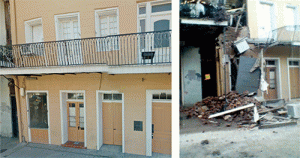Yesterday, the balcony on a building located in the historic French Quarter at 808 Royal Street suddenly, partially collapsed. There was obvious damage to the gas piping and plumbing, and a cloud of dust enveloped the street. Luckily, no one was hurt.
Today, the building itself started to crumble, closing the street again, and created an enormously dangerous situation for people on the street and in neighboring businesses and residences. The property will probably most likely have to be razed.
According to a neighboring business owner just next door, their store inventory may be ruined, but “the police won’t even let us go into the building to check the damage because it’s probably not safe. We don’t know when we’ll be able to go back in.”

808-10 Royal Street, before and after collapse (Photo, left: Google and Photo, right: frenchquarterbxb.com)
The business owner said that the owner (who was described as somewhat of a “hoarder”) lived in the building and that there was another apartment that was rented to a tenant that used the space as a “weekend home.”
“A large part of the building has been vacant for at least 10 years,” the business owner said. “That property has been in the owner’s family for years and while she’s been cited numerous times—in fact a suit was instituted by another adjoining property owner, who charged that the building was neglected, as he was afraid the wall would collapse. The owner has done cosmetic work to the building, but that’s it.”
With all the lip service this city and residential groups give to preserving the French Quarter (the usual preservationist blather), what system is there in place to make sure that these precious buildings are in fact, well-maintained and occupied? The Vieux Carre Commission and Historic District Landmarks Commission are more concerned with the outward appearance of these properties, not their structural integrity, apparently.
This is truly outrageous.
What is the city doing to make sure that historic properties are in good repair? And I don’t mean they are painted the correct color or that the balcony wrought iron is “of the period.”
I’ll present another example of why this is urgently needed. I live in an historic house, with another historic property immediately next to us. The houses are what you might call “zero lot-line” in that the house next door to us is literally part of our yard. We have a French Quarter-style patio with the next-door house as our border. There are five houses in a row and all of them are literally right on top of each other.
What if the house next to us would collapse, or even worse, catch on fire? The houses immediately next to it (including ours) would be in dire straits. The reason I mention this is that our neighbor has not lived in the property since before Katrina. The front of the house recently had some cosmetic work to the front façade (because the city had cited the property for neglect). But, I can assure you, the back of the house is in very poor condition, and it’s getting worse every day.
It seems as though even if the property is being cited, or lawsuits are being filed, that nothing is really being done to preserve historic building stock.
I don’t know what the solution is; perhaps the city needs to expand the honorary commissions like the VCC and HDLC to give them the ability to make sure that our historic properties are structurally sound, and if not, put the force of law so that the property owner is required to keep the property up.
I’ve seen this many times in the Quarter and the Marigny, and of course, have experienced it in my neighborhood. Two famous music clubs (Donna’s and the Funky Butt) on North Rampart fell into disrepair (and ultimate closure) because the property owner let the buildings deteriorate so much that they weren’t usable. (On another issue, it’s a very common practice for property owners to lease buildings in historic districts on a “triple-net” basis, which means that the tenant is responsible for keeping the building up. I think this should not be allowed in historic districts).
There’s just too much at stake for New Orleans’ historic properties to let them deteriorate because no one has developed a system to make the property owners liable and responsible.



